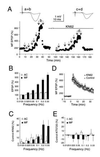Distinct short-term plasticity at two excitatory synapses in the hippocampus
- PMID: 8917586
- PMCID: PMC24088
- DOI: 10.1073/pnas.93.23.13304
Distinct short-term plasticity at two excitatory synapses in the hippocampus
Abstract
A single mossy fiber input contains several release sites and is located on the proximal portion of the apical dendrite of CA3 neurons. It is, therefore, well suited to exert a strong influence on pyramidal cell excitability. Accordingly, the mossy fiber synapse has been referred to as a detonator or teacher synapse in autoassociative network models of the hippocampus. The very low firing rates of granule cells [Jung, M. W. & McNaughton, B. L. (1993) Hippocampus 3, 165-182], which give rise to the mossy fibers, raise the question of how the mossy fiber synapse temporally integrates synaptic activity. We have therefore addressed the frequency dependence of mossy fiber transmission and compared it to associational/commissural synapses in the CA3 region of the hippocampus. Paired pulse facilitation had a similar time course, but was 2-fold greater for mossy fiber synapses. Frequency facilitation, during which repetitive stimulation causes a reversible growth in synaptic transmission, was markedly different at the two synapses. At associational/ commissural synapses facilitation occurred only at frequencies greater than once every 10 s and reached a magnitude of about 125% of control. At mossy fiber synapses, facilitation occurred at frequencies as low as once every 40 s and reached a magnitude of 6-fold. Frequency facilitation was dependent on a rise in intraterminal Ca2+ and activation of Ca2+/calmodulin-dependent kinase II, and was greatly reduced at synapses expressing mossy fiber long-term potentiation. These results indicate that the mossy fiber synapse is able to integrate granule cell spiking activity over a broad range of frequencies, and this dynamic range is substantially reduced by long-term potentiation.
Figures






References
-
- Castro-Alamancos M A, Connors B W. Science. 1996;272:274–277. - PubMed
-
- Dempsey E W, Morison R S. Am J Physiol. 1943;138:283–296.
-
- Bliss T V P, Collingridge G L. Nature (London) 1993;361:31–39. - PubMed
-
- Nicoll R A, Malenka R C. Nature (London) 1995;377:115–118. - PubMed
-
- Buonomano D V, Merzenich M M. Science. 1995;267:1028–1030. - PubMed
Publication types
MeSH terms
Substances
LinkOut - more resources
Full Text Sources
Other Literature Sources
Miscellaneous

